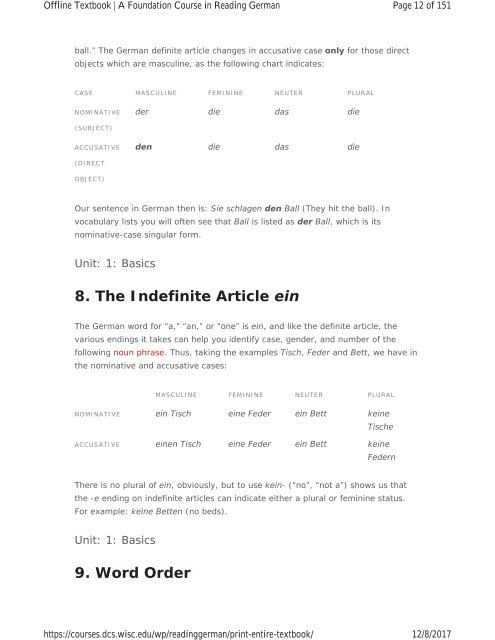A Foundation Course in Reading German, 2017a
A Foundation Course in Reading German, 2017a
A Foundation Course in Reading German, 2017a
Create successful ePaper yourself
Turn your PDF publications into a flip-book with our unique Google optimized e-Paper software.
Offl<strong>in</strong>e Textbook | A <strong>Foundation</strong> <strong>Course</strong> <strong>in</strong> Read<strong>in</strong>g <strong>German</strong><br />
https://courses.dcs.wisc.edu/wp/read<strong>in</strong>ggerman/pr<strong>in</strong>t-entire-textbook/<br />
Page 12 of 151<br />
12/8/2017<br />
ball.” The <strong>German</strong> def<strong>in</strong>ite article changes <strong>in</strong> accusative case only for those direct<br />
objects which are mascul<strong>in</strong>e, as the follow<strong>in</strong>g chart <strong>in</strong>dicates:<br />
CASE MASCULINE FEMININE NEUTER PLURAL<br />
NOMINATIVE<br />
der die das die<br />
(SUBJECT)<br />
ACCUSATIVE<br />
den die das die<br />
(DIRECT<br />
OBJECT)<br />
Our sentence <strong>in</strong> <strong>German</strong> then is: Sie schlagen den Ball (They hit the ball). In<br />
vocabulary lists you will often see that Ball is listed as der Ball, which is its<br />
nom<strong>in</strong>ative-case s<strong>in</strong>gular form.<br />
Unit: 1: Basics<br />
8. The Indef<strong>in</strong>ite Article e<strong>in</strong><br />
The <strong>German</strong> word for “a,” “an,” or “one” is e<strong>in</strong>, and like the def<strong>in</strong>ite article, the<br />
various end<strong>in</strong>gs it takes can help you identify case, gender, and number of the<br />
follow<strong>in</strong>g noun phrase. Thus, tak<strong>in</strong>g the examples Tisch, Feder and Bett, we have <strong>in</strong><br />
the nom<strong>in</strong>ative and accusative cases:<br />
MASCULINE FEMININE NEUTER PLURAL<br />
NOMINATIVE e<strong>in</strong> Tisch e<strong>in</strong>e Feder e<strong>in</strong> Bett ke<strong>in</strong>e<br />
Tische<br />
ACCUSATIVE e<strong>in</strong>en Tisch e<strong>in</strong>e Feder e<strong>in</strong> Bett ke<strong>in</strong>e<br />
Federn<br />
There is no plural of e<strong>in</strong>, obviously, but to use ke<strong>in</strong>- (“no”, “not a”) shows us that<br />
the -e end<strong>in</strong>g on <strong>in</strong>def<strong>in</strong>ite articles can <strong>in</strong>dicate either a plural or fem<strong>in</strong><strong>in</strong>e status.<br />
For example: ke<strong>in</strong>e Betten (no beds).<br />
Unit: 1: Basics<br />
9. Word Order


















